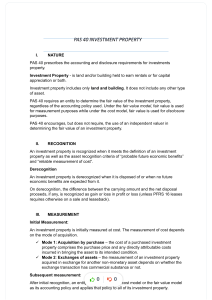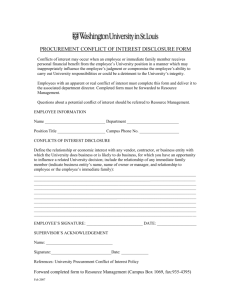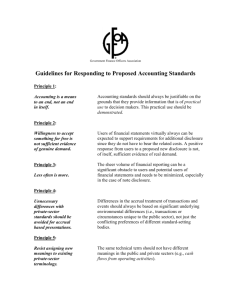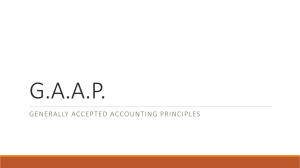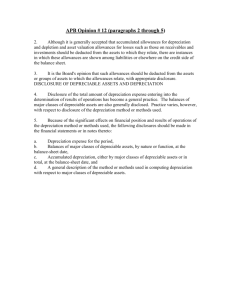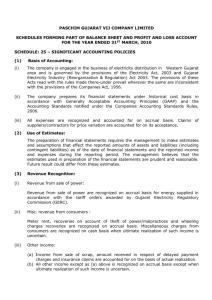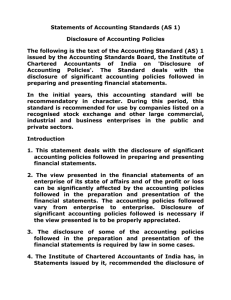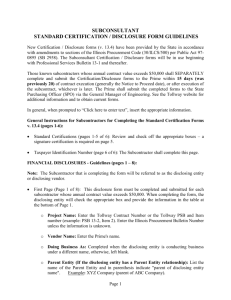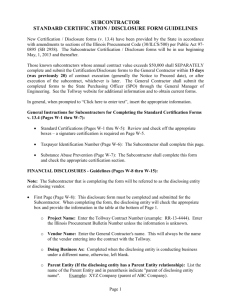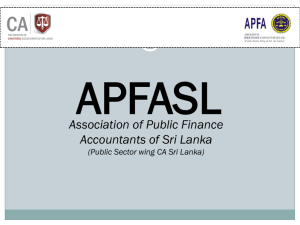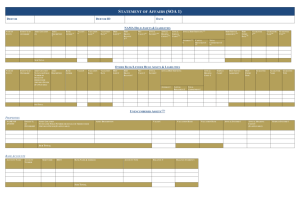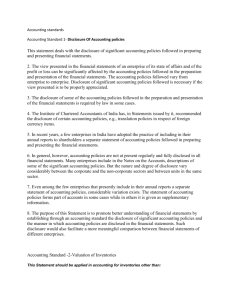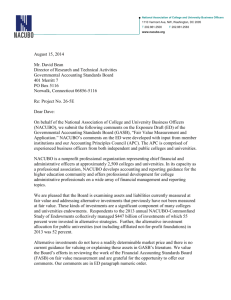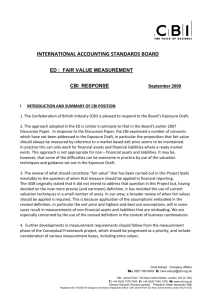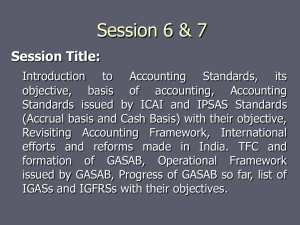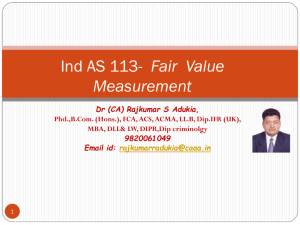Accounting Standard 1 (AS 1) - Disclosure of Accounting Policies
advertisement
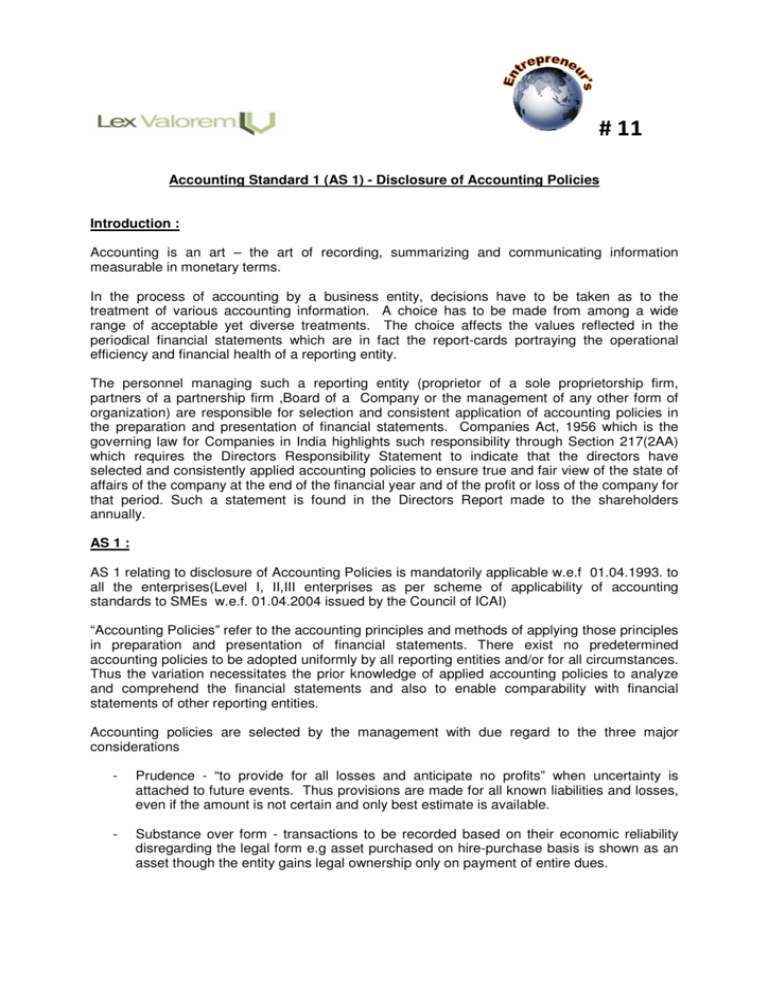
# 11 Accounting Standard 1 (AS 1) - Disclosure of Accounting Policies Introduction : Accounting is an art – the art of recording, summarizing and communicating information measurable in monetary terms. In the process of accounting by a business entity, decisions have to be taken as to the treatment of various accounting information. A choice has to be made from among a wide range of acceptable yet diverse treatments. The choice affects the values reflected in the periodical financial statements which are in fact the report-cards portraying the operational efficiency and financial health of a reporting entity. The personnel managing such a reporting entity (proprietor of a sole proprietorship firm, partners of a partnership firm ,Board of a Company or the management of any other form of organization) are responsible for selection and consistent application of accounting policies in the preparation and presentation of financial statements. Companies Act, 1956 which is the governing law for Companies in India highlights such responsibility through Section 217(2AA) which requires the Directors Responsibility Statement to indicate that the directors have selected and consistently applied accounting policies to ensure true and fair view of the state of affairs of the company at the end of the financial year and of the profit or loss of the company for that period. Such a statement is found in the Directors Report made to the shareholders annually. AS 1 : AS 1 relating to disclosure of Accounting Policies is mandatorily applicable w.e.f 01.04.1993. to all the enterprises(Level I, II,III enterprises as per scheme of applicability of accounting standards to SMEs w.e.f. 01.04.2004 issued by the Council of ICAI) “Accounting Policies” refer to the accounting principles and methods of applying those principles in preparation and presentation of financial statements. There exist no predetermined accounting policies to be adopted uniformly by all reporting entities and/or for all circumstances. Thus the variation necessitates the prior knowledge of applied accounting policies to analyze and comprehend the financial statements and also to enable comparability with financial statements of other reporting entities. Accounting policies are selected by the management with due regard to the three major considerations - Prudence - “to provide for all losses and anticipate no profits” when uncertainty is attached to future events. Thus provisions are made for all known liabilities and losses, even if the amount is not certain and only best estimate is available. - Substance over form - transactions to be recorded based on their economic reliability disregarding the legal form e.g asset purchased on hire-purchase basis is shown as an asset though the entity gains legal ownership only on payment of entire dues. # 11 - “Materiality” - requires material items to be shown separately and forms the basis for the process of recognition, aggregation, classification and presentation of accounting information. Material items are those, the knowledge of which might influence the decisions of the users of the Financial Statements. In simple terms, the items not considered as material are aggregated and lose their identity, thus are not separately disclosed in the financial statements. As per AS 1, the following have been generally accepted as fundamental accounting assumptions underlying the preparation and presentation of financial statements: 1. Going Concern – The enterprise has no intention of winding up its operations in the near future. This is the reason for charging depreciation on assets over a period of more than an year and carrying forward the balances in the asset and liability accounts with the intent to utilize the resources, recover the dues, repay liabilities over a span of several years. 2. Accrual Concept – The revenue and costs are recognized and recorded in the period to which they relate. Therefore under the accrual concept, revenue is recognized when it is earned and the expenses are recognized when they are incurred, irrespective of actual receipt or payment in cash. 3. Consistency Concept – Accounting policies are followed on a consistent basis from one period to another and for similar items within the same accounting period. However as per AS 5, changes in accounting policy are permissible only if required by statute or for compliance with an accounting standard or if the change would result in more appropriate presentation of the financial statements. Para 14 of this AS lists out some examples of areas in which different accounting policies may be adopted by different enterprises:(a) Methods of depreciation, depletion and amortization (b) Treatment of expenditure during construction (c) Conversion or translation of foreign currency items (d) Valuation of inventories (e) Treatment of goodwill (f) Valuation of investments (g) Treatment of retirement benefits (h) Recognition of profit on long-term contracts (i) Valuation of fixed assets (j) Treatment of contingent liabilities. The Disclosure requirements in brief with regard to the accounting policies are: The significant accounting policies must be disclosed at one place and should form part of the financial statements. Usually it is found in the “Notes to Accounts” forming part of the financial statements. # 11 Any changes in the accounting policy which shall have material effect on the financial statements either in the current period or in the later periods requires appropriate disclosure(including quantification of such change) in the period in which the change is adopted. The amount of change if not ascertainable then such fact must be indicated. Specific disclosure is required with regard to the 3 fundamental accounting assumptions as stated above only if they are not followed. What purpose does this Accounting Standard Serve? As this is a mandatory Standard, every enterprise needs to adhere to the same. The term “mandatory” implies that in the event of non adherence to this Standard, the auditor has the duty to disclose such deviations in his report. Thereby, a person analyzing the Financial Statements can consider that the 3 fundamental accounting assumptions of going concern, accrual and consistency have been followed by the enterprise unless any contrary disclosure is made by the management in this regard. Let us assume that Straight Line method of Depreciation has been adopted by an enterprise consistently for charging depreciation on its assets since the commencement of its operations. In a specific year, it changes the method of charging depreciation to Written Down Value method to ensure more appropriate presentation of financial statements. Since there is a change in the consistently adopted method, the management should disclose the amount by which the profit has been affected and the resulting change in the value of the asset as reflected in the Balance sheet. Understanding such changes enable better comparison with the financial statements of the entity for different accounting periods, or with financial statements of other entities. Bhavya Parvathi . K
